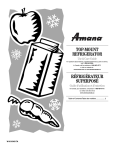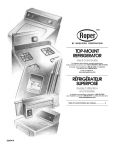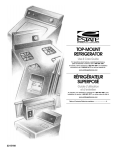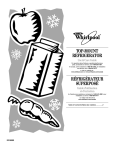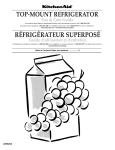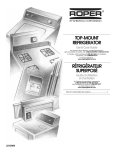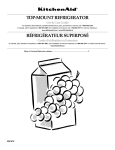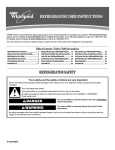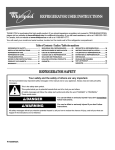Download Whirlpool 2316016 Use & care guide
Transcript
TOP-MOUNT REFRIGERATOR Use & Care Guide For questions about features, operation/performance, parts or service, call: 1-800-253-1301. In Canada, call for assistance 1-800-807-6777, or visit our website at... www.whirlpool.com or www.whirlpool.ca REFRIGERADOR CON MONTAJE SUPERIOR Manual de Uso y Cuidado Para consultas respecto a características, operación/desempeño, partes, accesorios o servicio, llame al: 1-800-253-1301. En Canadá, llame al: 1-800-807-6777 o visite nuestra página de internet.. www.whirlpool.com or www.whirlpool.ca RÉFRIGÉRATEUR SUPERPOSÉ Guide d’utilisation et d’entretien Au Canada, pour assistance, composez le 1-800-807-6777. ou visitez notre site web à www.whirlpool.ca Table of Contents/Índice/Table des matières ............................ 2 2316016 TABLE OF CONTENTS REFRIGERATOR SAFETY .............................................................3 Proper Disposal of Your Old Refrigerator....................................3 INSTALLATION INSTRUCTIONS ..................................................4 Unpack the Refrigerator...............................................................4 Location Requirements ................................................................4 Electrical Requirements ...............................................................5 Water Supply Requirements ........................................................5 Connect the Water Supply...........................................................5 Refrigerator Doors........................................................................6 Adjust the Doors.........................................................................10 Normal Sounds ..........................................................................10 REFRIGERATOR USE ..................................................................10 Ensuring Proper Air Circulation..................................................10 Using the Controls .....................................................................11 Ice Maker....................................................................................11 REFRIGERATOR FEATURES ......................................................12 Refrigerator Shelves...................................................................12 Meat Drawer...............................................................................12 Crisper ........................................................................................12 Utility or Egg Bin.........................................................................13 FREEZER FEATURES ..................................................................13 Freezer Shelf...............................................................................13 DOOR FEATURES ........................................................................14 Door Rails ...................................................................................14 Can Racks and Door Bins..........................................................14 REFRIGERATOR CARE ...............................................................14 Cleaning......................................................................................14 Changing the Light Bulbs...........................................................15 Power Interruptions ....................................................................15 Vacation and Moving Care.........................................................15 TROUBLESHOOTING ..................................................................16 ASSISTANCE OR SERVICE .........................................................18 In the U.S.A. ...............................................................................18 In Canada ...................................................................................18 Accessories ................................................................................18 WARRANTY ..................................................................................19 ÍNDICE SEGURIDAD DEL REFRIGERADOR...........................................20 Cómo deshacerse adecuadamente de su refrigerador viejo ....20 INSTRUCCIONES DE INSTALACIÓN.........................................21 Desempaque el refrigerador ......................................................21 Requisitos de ubicación.............................................................21 Requisitos eléctricos..................................................................22 Requisitos del suministro de agua.............................................22 Conexión del suministro de agua ..............................................22 Puertas del refrigerador .............................................................24 Ajuste las puertas.......................................................................27 Sonidos normales ......................................................................28 USO DE SU REFRIGERADOR.....................................................28 Cómo asegurar la debida circulación de aire............................28 Uso de los controles ..................................................................29 Fábrica de hielo..........................................................................29 CARACTERÍSTICAS DEL REFRIGERADOR ..............................30 Estantes del refrigerador............................................................30 Cajón para carnes ......................................................................30 Cajón para verduras ...................................................................30 Compartimiento para huevos o alimentos.................................31 CARACTERÍSTICAS DEL CONGELADOR .................................31 Estante del congelador ..............................................................31 CARACTERÍSTICAS DE LA PUERTA .........................................32 Rieles de la puerta......................................................................32 Portalatas y recipientes de la puerta .........................................32 CUIDADO DE SU REFRIGERADOR............................................32 Limpieza .....................................................................................32 Cómo cambiar los focos ............................................................33 Cortes de corriente.....................................................................33 Cuidado durante las vacaciones y mudanzas...........................33 SOLUCIÓN DE PROBLEMAS......................................................34 AYUDA O SERVICIO TÉCNICO...................................................36 En los EE.UU. .............................................................................36 En Canadá ..................................................................................36 Accesorios..................................................................................36 GARANTÍA.....................................................................................37 TABLE DES MATIÈRES SÉCURITÉ DU RÉFRIGÉRATEUR ..............................................38 Mise au rebut de votre vieux réfrigérateur.................................38 INSTRUCTIONS D’INSTALLATION ...........................................39 Déballage du réfrigérateur .........................................................39 Exigences d’emplacement.........................................................39 Spécifications électriques ..........................................................40 Spécifications de l’alimentation en eau .....................................40 Raccordement de la canalisation d’eau ....................................41 Portes du réfrigérateur ...............................................................42 Ajustement des portes ...............................................................46 Sons normaux ............................................................................46 UTILISATION DU RÉFRIGÉRATEUR..........................................46 Pour s’assurer d’une circulation d’air appropriée .....................46 Utilisation des commandes........................................................47 Machine à glaçons .....................................................................47 CARACTÉRISTIQUES DU RÉFRIGÉRATEUR ..........................48 Tablettes du réfrigérateur...........................................................48 2 Bac à viande...............................................................................48 Bac à légumes............................................................................49 Casier utilitaire ou oeufrier..........................................................49 CARACTÉRISTIQUES DU CONGÉLATEUR...............................50 Clayette du congélateur .............................................................50 CARACTÉRISTIQUES DE LA PORTE.........................................50 Tringles dans la porte.................................................................50 Porte-cannettes et balconnets...................................................50 ENTRETIEN DU RÉFRIGÉRATEUR ............................................51 Nettoyage ...................................................................................51 Remplacement des ampoules d’éclairage ................................51 Pannes de courant .....................................................................52 Entretien avant les vacances ou lors d’un déménagement.......52 DÉPANNAGE.................................................................................53 ASSISTANCE OU SERVICE.........................................................55 Accessoires ................................................................................55 GARANTIE.....................................................................................56 REFRIGERATOR SAFETY Your safety and the safety of others are very important. We have provided many important safety messages in this manual and on your appliance. Always read and obey all safety messages. This is the safety alert symbol. This symbol alerts you to potential hazards that can kill or hurt you and others. All safety messages will follow the safety alert symbol and either the word “DANGER” or “WARNING.” These words mean: You can be killed or seriously injured if you don't immediately follow instructions. DANGER You can be killed or seriously injured if you don't follow instructions. WARNING All safety messages will tell you what the potential hazard is, tell you how to reduce the chance of injury, and tell you what can happen if the instructions are not followed. IMPORTANT SAFETY INSTRUCTIONS WARNING: To reduce the risk of fire, electric shock, or injury to persons when using the refrigerator, follow basic precautions, including the following: ■ ■ ■ ■ ■ ■ ■ Plug into a grounded 3 prong outlet. Do not remove ground prong. Do not use an adapter. Do not use an extension cord. Disconnect power before servicing. Replace all parts and panels before operating. Remove doors from your old refrigerator. ■ ■ ■ ■ Use nonflammable cleaner. Keep flammable materials and vapors, such as gasoline, away from refrigerator. Use two or more people to move and install refrigerator. Disconnect power before installing ice maker (on ice maker kit ready models only). SAVE THESE INSTRUCTIONS Proper Disposal of Your Old Refrigerator ■ Leave the shelves in place so that children may not easily climb inside. WARNING Suffocation Hazard Remove doors from your old refrigerator. Failure to do so can result in death or brain damage. IMPORTANT: Child entrapment and suffocation are not problems of the past. Junked or abandoned refrigerators are still dangerous – even if they will sit for “just a few days.” If you are getting rid of your old refrigerator, please follow these instructions to help prevent accidents. Before You Throw Away Your Old Refrigerator or Freezer: ■ Take off the doors. 3 INSTALLATION INSTRUCTIONS Unpack the Refrigerator Location Requirements WARNING WARNING Excessive Weight Hazard Use two or more people to move and install refrigerator. Failure to do so can result in back or other injury. Explosion Hazard Keep flammable materials and vapors, such as gasoline, away from refrigerator. Remove the Packaging ■ Remove tape and glue residue from surfaces before turning on the refrigerator. Rub a small amount of liquid dish soap over the adhesive with your fingers. Wipe with warm water and dry. ■ Do not use sharp instruments, rubbing alcohol, flammable fluids, or abrasive cleaners to remove tape or glue. These products can damage the surface of your refrigerator. For more information, see “Refrigerator Safety.” ■ On some models, shelves, bins, door shelf rails, and other feature parts may be packaged in the Interior FeaturePak. Follow the instructions contained in the package for proper assembly. ■ There are four bolts that secure the refrigerator to the shipping case. Keep these bolts because they are the refrigerator's leveling legs. ■ Properly dispose of packaging. Failure to do so can result in death, explosion, or fire. To ensure proper ventilation for your refrigerator, allow for a ¹⁄₂" (12.70 mm) space on each side. Allow 3" (7.5 cm) of space between overhead cabinets and refrigerator top. Allow at least 1" (25.40 mm) between back of cabinet and the wall. If your refrigerator has an ice maker, make sure you leave some extra space at the back for the water line connections. ■ If you are installing your refrigerator next to a fixed wall, leave 2" (5.08 cm) minimum on the hinge side (depending on your model) to allow for the door to swing open. ■ Level the refrigerator. See “Adjust the Doors.” NOTE: It is recommended that you do not install the refrigerator near an oven, radiator, or other heat source. Do not install in a location where the temperature will fall below 55°F (13°C). IMPORTANT: Do not remove the white foam air return insert that is located behind the control panel on the ceiling of the refrigerator (on some models). The insert is part of the refrigerator and not part of the packing material. If the insert is removed, ice may migrate down from the freezer and cause icicles to form. When Moving Your Refrigerator: 3" (7.5 cm) Your refrigerator is heavy. When moving the refrigerator for cleaning or service, be sure to protect the floor. Always pull the refrigerator straight out when moving it. Do not wiggle or “walk” the refrigerator when trying to move it, as floor damage could occur. Clean Before Using After you remove all of the package materials, clean the inside of your refrigerator before using it. See the cleaning instructions in “Refrigerator Care.” Important information to know about glass shelves and covers: Do not clean glass shelves or covers with warm water when they are cold. Shelves and covers may break if exposed to sudden temperature changes or impact, such as bumping. For your protection, tempered glass is designed to shatter into many small, pebble-size pieces. This is normal. Glass shelves and covers are heavy. Use special care when removing them to avoid impact from dropping. 4 2" (5.08 cm) Reverse Osmosis Water Supply Electrical Requirements WARNING If a reverse osmosis water filtration system is connected to your cold water supply, the water pressure to the reverse osmosis system needs to be a minimum of 40 to 60 psi (276 - 414 kPa). If the ice maker is still not operating properly: ■ Check to see whether the sediment filter in the reverse osmosis system is blocked. Replace the filter if necessary. ■ Electrical Shock Hazard Allow the storage tank on the reverse osmosis system to refill after heavy usage. If you have questions about your water pressure, call a licensed, qualified plumber. Plug into a grounded 3 prong outlet. Connect the Water Supply Do not remove ground prong. Do not use an adapter. Do not use an extension cord. Failure to follow these instructions can result in death, fire, or electrical shock. Before you move your refrigerator into its final location, it is important to make sure you have the proper electrical connection. Recommended Grounding Method A 115 Volt, 60 Hz., AC only 15- or 20-amp fused, grounded electrical supply is required. It is recommended that a separate circuit serving only your refrigerator be provided. Use an outlet that cannot be turned off by a switch. Do not use an extension cord. NOTE: Before performing any type of installation, cleaning, or removing a light bulb, turn the control (Thermostat, Refrigerator or Freezer Control depending on the model) OFF and then disconnect the refrigerator from the electrical source. When you are finished, reconnect the refrigerator to the electrical source and reset the control (Thermostat, Refrigerator or Freezer Control depending on the model) to the desired setting. Water Supply Requirements (on some models) Read all directions before you begin. IMPORTANT: If you turn the refrigerator on before the water line is connected, turn the ice maker OFF. Connect to Water Line 1. Unplug refrigerator or disconnect power. 2. Turn OFF main water supply. Turn ON nearest faucet long enough to clear line of water. 3. Locate a ¹⁄₂" to 1¹⁄₄" (1.27 cm to 3.18 cm) vertical cold water pipe near the refrigerator. IMPORTANT: ■ Make sure it is a cold water pipe. ■ Horizontal pipe will work, but drill on the top side of the pipe, not the bottom. This will help keep water away from the drill and normal sediment from collecting in the valve. 4. Determine the length of copper tubing you will need. Measure from the connection on lower left rear of refrigerator to the water pipe. Add 7 ft (2.1 m) to allow for cleaning. Use ¹⁄₄" (6.35 mm) O.D. (outside diameter) copper tubing. Be sure both ends of copper tubing are cut square. 5. Using a grounded drill, drill a ¹⁄₄" hole in the cold water pipe you have selected. Read all directions before you begin. A IMPORTANT: ■ If you turn the refrigerator on before the water line is connected, turn the ice maker OFF. ■ All installations must meet local plumbing code requirements. ■ Use copper tubing and check for leaks. Install copper tubing only in areas where the household temperatures will remain above freezing. TOOLS NEEDED: Flat-blade screwdriver, ⁷⁄₁₆" and ¹⁄₂" open-end wrenches or 2 adjustable wrenches, ¹⁄₄" nut driver and drill bit, hand drill or electric drill (properly grounded). Gather the required tools and parts before starting installation. Read and follow the instructions provided with any tools listed. NOTE: Your refrigerator dealer has a kit available with a ¹⁄₄" (6.35 mm) saddle-type shutoff valve, a union, and copper tubing. Before purchasing, make sure a saddle-type valve complies with your local plumbing codes. Do not use a piercing-type or ³⁄₁₆" (4.76 mm) saddle valve which reduces water flow and clogs more easily. Water Pressure A cold water supply with water pressure of between 30 and 120 psi (207-827 kPa) is required to operate the ice maker. If you have questions about your water pressure, call a licensed, qualified plumber. B G C F E A. Cold water pipe B. Pipe clamp C. Copper tubing D. Compression nut D E. Compression sleeve F. Shutoff valve G. Packing nut 6. Fasten the shutoff valve to the cold water pipe with the pipe clamp. Be sure the outlet end is solidly in the ¹⁄₄" drilled hole in the water pipe and that the washer is under the pipe clamp. Tighten the packing nut. Tighten the pipe clamp screws slowly and evenly so washer makes a watertight seal. Do not overtighten or you may crush the copper tubing. 7. Slip the compression sleeve and compression nut on the copper tubing as shown. Insert the end of the tubing into the outlet end squarely as far as it will go. Screw compression nut onto outlet end with adjustable wrench. Do not overtighten. 8. Place the free end of the tubing in a container or sink, and turn ON the main water supply. Flush the tubing until water is clear. Turn OFF the shutoff valve on the water pipe. Coil the copper tubing. 5






